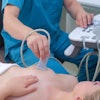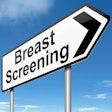Women who adhere to their annual screening mammography schedule are less like to have false-positive results and, subsequently, undergo unnecessary biopsies, according to Boston researchers, who reviewed more than 300,000 records for their study in the August issue of Radiology.
In addition, the risk of a woman undergoing biopsy with false-positive (FP) results decreases if she regularly underwent screening, wrote lead author Karen Blanchard from the department of surgery at Massachusetts General Hospital (MGH) in Boston. Her co-authors included Dr. Daniel Kopans and Elkan Halpern, Ph.D., from the MGH department of radiology, as well as James Michaelson, Ph.D., from the pathology department.
"The data presented (in the study) reveal that much of the burden of false-positive events can be ascribed to the failure of women to return for annual mammography," the authors stated. "The data reported here suggest that the use of interventions to encourage a prompt return to screening should have a substantial effect ... in terms of a reduction in false-positive events" (Radiology, August 2006, Vol. 240:2, pp. 335-342).
For this retrospective review, the group used 314,185 mammograms obtained in 83,511 women (1985-2002) at the MGH Avon Foundation Comprehensive Breast Evaluation Center. The database also contained breast-tissue pathology reports.
The occurrence of FP events was compiled for three overlapping groups: the five-year group (1996-2000) and the eight-year group (1993-2000) with either a positive or negative bilateral mammographic screening result, and a 10-year group (1991-2001) with a negative screening result. Two categories of FP events were examined: biopsies that did not reveal cancer and FP mammographic results.
Data from the 10-year group provided information over the longest time period and also offered information on women who underwent screening at other facilities. With the two other groups, it was possible to examine changes in the FP risk over time, the authors explained.
According to the results, of the women who had a negative screening in 1991, 8.04% underwent biopsy that did not reveal cancer within a decade. This FP burden fell on the women who underwent sporadic screening. In the five-year group of women who were screened every year, only 2.9% of the women underwent biopsy without a cancer result. In contrast, biopsy without a cancer prognosis occurred in 4.6% of the women who had three mammograms over five years.
"For women who underwent regular screening, the risk of undergoing biopsies that did not reveal cancer declined over time to 0.25% per year after several years of screening," the group reported. Most of the FP events were BI-RADS category 0; FP assessments for BI-RADS 5 were rare, they added.
These results are markedly different than an earlier study, which estimated that the cumulative risk of an FP result was 49.1% after 10 mammograms, Blanchard's team stated (New England Journal of Medicine, April 16, 1998, Vol. 338:16, pp. 1089-1096).
"We have been able to measure the actual occurrence of these false-positive assessments among women who underwent 10 consecutive mammographic procedures over a 10-year period. Thus, our results reveal a substantially lower value (29.2%)," they wrote.
The researchers acknowledged that the single screening population was a limitation of their study; however, their results regarding overall number of biopsies that did not reveal cancer did not differ from studies that looked at a more general population.
In addition to finding ways to encourage women to undergo annual screening, their study revealed that attention should also be focused on reducing FP events in the first few years of screening, they said.
By Shalmali Pal
AuntMinnie.com staff writer
August 9, 2006
Related Reading
Sidestepping screening: What factors make women avoid annual mammography?, October 10, 2005
Benefit of breast cancer screening small - study, July 20, 2005
Breast imaging expert accuses major journals of bias against mammo, July 20, 2005
Women fail to return for annual mammograms, June 23, 2004
Copyright © 2006 AuntMinnie.com



















